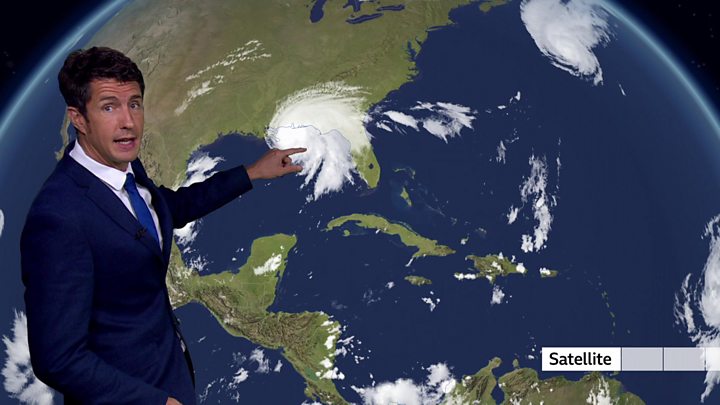
Media playback is unsupported on your device
Hurricane Sally has crashed into the southern US in slow motion, bringing torrential rain and storm surges, smashing boats and breaking bridges.
It made landfall as a Category 2 and although now a tropical storm, its glacial pace means there are still warnings of danger to life.
Pensacola, Florida, was badly hit, with a loose barge bringing down part of the Bay Bridge.
There are also storm surge warnings for Alabama as Sally heads north.
At 16:00 local time (21:00 GMT), Sally was 55 miles (88km) north of Pensacola and close to the Alabama border. Its 7mph speed in a north-easterly direction is almost a sprint - at one point it was 3mph.
Sally made landfall at Gulf Shores, Alabama, at 04:45 local time on Wednesday, with maximum wind speeds of 105mph.
The latest speeds are put at about 60mph, but it has been the torrents of rainfall and high storm surges that have been its most damaging factors.

Media playback is unsupported on your device
Hurricane Sally is one of several storms in the Atlantic Ocean, with officials running out of letters to name the hurricanes as they near the end of their annual alphabetic list.
What's the latest on damage?
The National Hurricane Center (NHC) reports that "catastrophic and life-threatening flooding continues over portions of the Florida Panhandle and southern Alabama".
Rainfall is being measured in feet rather than inches in some places, but 18in (45cm) has been recorded across many areas.
Flooding to a depth of 5ft hit central Pensacola. The storm surge was the third worst ever to hit the city. Police there told people not to go out to look at the damage, saying: "It's slowing our progress down. Please stay at home!"
Although the winds did not have the devastating power of the deadly Hurricane Laura, which struck last month, they still ripped boats from moorings and sent one barge careering into the under-construction Bay Bridge. They were certainly high enough to topple high-sided vehicles.
Image copyright Reuters Image caption One of the barges that broke free in Pensacola, FloridaAnother barge got loose and headed for the Escambia Bay Bridge but luckily ran ashore.
The sheriff of Escambia County said it had not been expecting the devastation wrought by Sally.
Image copyright Reuters Image caption Overturned vehicle in Mobile, Alabama. Many roads there were hit by falling treesCavin Hollyhand, 50, who lives in Mobile, Alabama, told Reuters: "The rain is what stands out with this one: It's unreal."
There remains "a danger of life-threatening inundation" on the Florida-Alabama border, the NHC said.
Alabama Governor Kay Ivey said many areas around Mobile were seeing historic flood levels and urged people to heed warnings.
The pier at Gulf State Park in Alabama suffered significant damage.
Image copyright Reuters Image caption Gulf Shores in Alabama hosted Sally's landfall and its torrential rainThe latest on power cuts from the poweroutage.us website lists some 290,000 customers without electricity in Alabama and 253,000 more in Florida.
As well as pylons being brought down, many trees were uprooted.
Rain appeared to fall sideways in Alabama, which led to submerged roads as the storm inched ashore. Other areas along the coast were also affected, with beaches and highways swamped in Mississippi and low-lying properties in Louisiana covered by the rising waters.
Alabama, Florida and Mississippi all declared states of emergency ahead of the storm.
Why the slow pace and what's next?
John De Block, at the National Weather Service in Birmingham, Alabama, told the New York Times that Sally was drifting "at the speed of a child in a candy shop".
Sally's pace may be linked to climate change, according to experts. A 2018 study in Nature magazine found that the speed at which hurricanes and tropical storms move over an area had decreased by 10% between 1949 and 2016, a drop that was linked to an increase in total rainfall.
"Sally has a characteristic that isn't often seen, and that's a slow forward speed and that's going to exacerbate the flooding," NHC deputy director Ed Rappaport told the Associated Press.
In addition to Sally, there are four other tropical cyclones - Paulette, Rene, Teddy and Vicky - swirling in the Atlantic Ocean basin.
If only one more storm is officially named - Wilfred has already been chosen - meteorologists will run out of preselected names for the rest of the year and so will begin naming new storms after the Greek alphabet.

 5 years ago
786
5 years ago
786 

